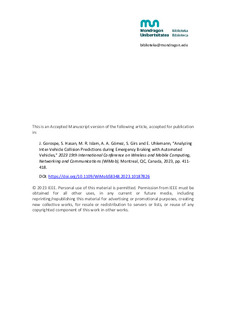| dc.contributor.author | Gorospe, Joseba | |
| dc.contributor.author | Alonso Gómez, Arrate | |
| dc.contributor.other | Hasan, Shahriar | |
| dc.contributor.other | Islam, Mir Riyanul | |
| dc.contributor.other | Girs, Svetlana | |
| dc.contributor.other | Uhlemann, Elisabeth | |
| dc.date.accessioned | 2024-02-19T14:44:18Z | |
| dc.date.available | 2024-02-19T14:44:18Z | |
| dc.date.issued | 2023 | |
| dc.identifier.isbn | 979-8-3503-3667-2 | en |
| dc.identifier.issn | 2160-4886 | en |
| dc.identifier.other | https://katalogoa.mondragon.edu/janium-bin/janium_login_opac.pl?find&ficha_no=173332 | en |
| dc.identifier.uri | https://hdl.handle.net/20.500.11984/6260 | |
| dc.description.abstract | Automated Vehicles (AVs) require sensing and perception to integrate data from multiple sources, such as cameras, lidars, and radars, to operate safely and efficiently. Collaborative sensing through wireless vehicular communications can enhance this process. However, failures in sensors and communication systems may require the vehicle to perform a safe stop or emergency braking when encountering hazards. By identifying the conditions for being able to perform emergency braking without collisions, better automation models that also consider communications need to be developed. Hence, we propose to employ Machine Learning (ML) to predict inter-vehicle collisions during emergency braking by utilizing a comprehensive dataset that has been prepared through rigorous simulations. Using simulations and data-driven modeling has several advantages over physics-based models in this case, as it, e.g., enables us to provide a dataset with varying vehicle kinematic parameters, traffic density, network load, vehicle automation controller parameters, and more. To further establish the conditions for inter-vehicle collisions, we analyze the predictions made through interpretable ML models and rank the features that contribute to collisions. We also extract human-interpretable rules that can establish the conditions leading to collisions between AVs during emergency braking. Finally, we plot the decision boundaries between different input features to separate the collision and non-collision classes and demonstrate the safe region of emergency braking. | en |
| dc.language.iso | eng | en |
| dc.publisher | IEEE | en |
| dc.rights | © 2023 IEEE | en |
| dc.subject | Wireless communication | en |
| dc.subject | analytical modeling | en |
| dc.subject | Wireless sensor networks | en |
| dc.subject | Automation | en |
| dc.subject | Machine learning | en |
| dc.subject | Predictive model | en |
| dc.subject | Sensor systems | en |
| dc.subject | ODS 9 Industria, innovación e infraestructura | es |
| dc.title | Analyzing Inter-Vehicle Collision Predictions during Emergency Braking with Automated Vehicles | en |
| dc.type | http://purl.org/coar/resource_type/c_c94f | |
| dcterms.accessRights | http://purl.org/coar/access_right/c_f1cf | en |
| dcterms.source | International Conference on Wireless and Mobile Computing, Networking and Communications | en |
| local.contributor.group | Teoría de la señal y comunicaciones | es |
| local.description.peerreviewed | true | en |
| local.description.publicationfirstpage | 411 | en |
| local.description.publicationlastpage | 418 | en |
| local.identifier.doi | https://doi.org/10.1109/WiMob58348.2023.10187826 | en |
| local.embargo.enddate | 2025-06-30 | |
| local.contributor.otherinstitution | Mälardalen University | es |
| local.source.details | 2023. Vol. June. Pp. 411-418 | en |
| oaire.format.mimetype | application/pdf | en |
| oaire.file | $DSPACE\assetstore | en |
| oaire.resourceType | http://purl.org/coar/resource_type/c_c94f | en |
| oaire.version | http://purl.org/coar/version/c_ab4af688f83e57aa | en |
| oaire.funderName | Eusko Jaurlaritza = Gobierno Vasco | |
| oaire.funderName | Eusko Jaurlaritza = Gobierno Vasco | |
| oaire.funderName | European Commission | |
| oaire.funderName | European Commission | |
| oaire.funderIdentifier | https://ror.org/00pz2fp31 http://data.crossref.org/fundingdata/funder/10.13039/501100003086 | |
| oaire.funderIdentifier | https://ror.org/00pz2fp31 http://data.crossref.org/fundingdata/funder/10.13039/501100003086 | |
| oaire.funderIdentifier | https://ror.org/00k4n6c32 http://data.crossref.org/fundingdata/funder/10.13039/501100000780 | |
| oaire.funderIdentifier | https://ror.org/00k4n6c32 http://data.crossref.org/fundingdata/funder/10.13039/501100000780 | |
| oaire.fundingStream | Ikertalde Convocatoria 2022-2023 | |
| oaire.fundingStream | Elkartek 2021 | |
| oaire.fundingStream | H2020 | |
| oaire.fundingStream | H2020-ECSEL | |
| oaire.awardNumber | IT1451-22 | |
| oaire.awardNumber | KK-2021-00123 | |
| oaire.awardNumber | 764951 | |
| oaire.awardNumber | 101007350 | |
| oaire.awardTitle | Teoría de la Señal y Comunicaciones | |
| oaire.awardTitle | Evolución tecnológica para la automatización multivehicular y evaluación de funciones de conducción altamente automatizadas (AUTOEV@L) | |
| oaire.awardTitle | Immersive Visual Technologies for Safety-critical Applications (ImmerSAFE) | |
| oaire.awardTitle | AI-augmented automation for efficient DevOps, a model-based framework for continuous development At RunTime in cyber-physical systems (AIDOaRt) | |
| oaire.awardURI | Sin información | |
| oaire.awardURI | Sin información | |
| oaire.awardURI | https://doi.org/10.3030/764951 | |
| oaire.awardURI | https://doi.org/10.3030/101007350 | |







